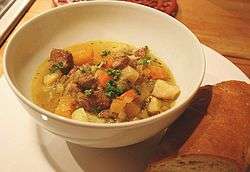Cawl
|
Cawl with unthickened stock | |
| Type | Broth |
|---|---|
| Place of origin | Wales |
| Main ingredients | Potatoes, swedes, carrots, meat |
|
| |
Cawl (pronounced [kaul]) is a Welsh dish. In modern Welsh the word is used to refer to any soup or broth. In English the word is used to refer to a traditional Welsh soup. Historically, ingredients tended to vary, but the most common recipes included salted bacon or beef with potatoes, swedes, carrots and other seasonal vegetables. Modern variations of the meal tend to use lamb and leek. Cawl is recognised as a national dish of Wales.
History
With recipes dating back to the 14th century, cawl is widely considered to be the national dish of Wales.[1] Cawl was traditionally eaten during the winter months in the south-west of Wales.[2] Today the word is often used to refer to a dish containing lamb and leeks, due to their association with Welsh culture, but historically it was made with either salted bacon or beef, along with swedes, carrots and other seasonal vegetables.[2] With the introduction of potatoes into the European diet in the latter half of the 16th century, this too would become a core ingredient in the recipe.
The meat in the dish was normally cut into medium-sized pieces and simmered with the vegetables in water. The stock was thickened with either oatmeal or flour, and was then served, without the meat or vegetables, as a first course.[2] The vegetables and slices of the meat would then be served as a second course.[2] Cawl served as a single course is today the most popular way to serve the meal, which is similar to its north Wales equivalent lobsgows. Lobsgows differs in that the meat and vegetables were cut into smaller pieces and the stock was not thickened.[2]
"Cawl cennin", or leek cawl, can be made without meat but using meat stock. In some areas cawl is often served with bread and cheese. These are served separately on a plate. The dish was traditionally cooked in an iron pot or cauldron over the fire[3] and eaten with wooden spoons.[4]
In Welsh, gwneud cawl o [rywbeth] ("make a cawl of [something]") means to mess something up.
Etymology
The word cawl in Welsh is first recorded in the 14th century, and is thought to come from the Latin caulis, meaning the stalk of a plant, a cabbage stalk or a cabbage. An alternative suggestion is that it is from Latin calidus, meaning warm, as this is the source of Spanish caldo, with the senses of broth or gravy.
See also
Notes
- ↑ Staff (5 March 2010). "Children celebrate St David's Day with traditional cawl". BBC News. Retrieved 13 March 2012.
- 1 2 3 4 5 Davies, (2008) p.130
- ↑ Staff (26 February 2006). "Captain Alfie laps up cawl crawl". BBC News. Retrieved 13 March 2012.
- ↑ Freeman (1980) p.82
Further reading
- Davies, John; Jenkins, Nigel; Menna, Baines; Lynch, Peredur I., eds. (2008). The Welsh Academy Encyclopaedia of Wales. Cardiff: University of Wales Press. ISBN 978-0-7083-1953-6.
- Freeman, Bobby (1980). First Catch Your Peacock, a book of Welsh food. Griffithstown, Gwent: Image Imprint. ISBN 0-9507254-1-2.
